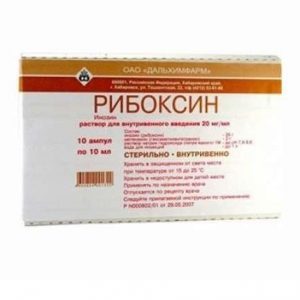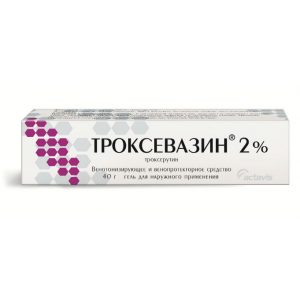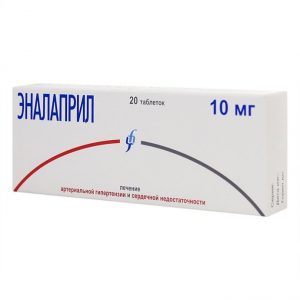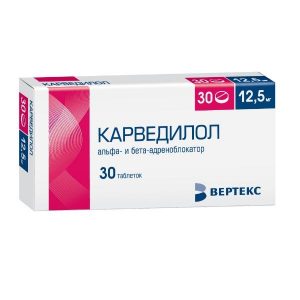Description
Packing
10 ampoules of 5 ml.
Pharmacological action
Pentoxifylline is a xanthine derivative. Improves microcirculation and rheological properties of blood. The mechanism of action is associated with inhibition of phosphodiesterase and an increase in the content of cyclic 3,5 adenosine monophosphate (3,5-AMP) in platelets and adenosine triphosphate (ATP) in red blood cells with simultaneous saturation of the energy potential, which in turn leads to vasodilation and a decrease in total peripheral vascular resistance, an increase in systolic and minute blood volume without a significant change in heart rate. Expanding the coronary arteries, increases oxygen delivery to the myocardium (a slight antianginal effect), lung vessels – improves blood oxygenation.
When administered intravenously, it leads to increased collateral circulation, an increase in the volume of flowing blood through a unit section.
Reduces blood viscosity, causes platelet disaggregation, increases the elasticity of red blood cells (due to the impact on pathologically altered deformability of red blood cells). Improves microcirculation in areas of impaired circulation.
In case of occlusive lesion of peripheral arteries (“intermittent” lameness), it leads to an increase in walking distance, elimination of night cramps of calf muscles and pain at rest.
Pharmacokinetics
The drug is rapidly metabolized in the liver after administration. In the process of metabolism, two main metabolites are formed: 1- (5-hydroxyhexyl) -3,7-dimethylxanthine (metabolite I) and 1- (3-carboxypropyl) -3,7-dimethylxanthine (metabolite V), which have similar pentoxifylline activity . 1.5-2 hours after infusion, the concentration of metabolites I and V in the blood plasma is 5 and 8 times higher than the concentration of the starting substance, respectively. By the 8th hour, the concentration of pentoxifylline and its metabolites in the blood is significantly reduced (up to 10% of the initial).
Elimination half-life from 30 minutes to 1.5 hours. It is excreted mainly by the kidneys (94%) in the form of metabolites (mainly metabolite V), by the intestines (4%). in the first 4 hours, up to 90% of the dose is excreted. In unchanged form, 2% of the drug is excreted. Pentoxifylline and its metabolites do not bind to plasma proteins.
Excreted in breast milk.
In severe renal impairment, excretion of metabolites is slowed down. In case of impaired liver function, an elimination half-life and increased bioavailability are noted.
Indications
Peripheral circulatory disorders IIb stage according to the Fontaine classification (“intermittent” claudication): as an initial or supporting treatment for the administration of pentoxifylline orally, in combination with surgical treatment or in the preoperative period, or in case of impossibility of surgical treatment of diabetic angiopathy.
Trophic disorders (e.g., leg ulcers or gangrene).
Cerebrovascular disease of atherosclerotic origin.
Degenerative changes against the background of vascular pathology of the inner ear and hearing loss (deafness, hearing loss, etc.), circulatory disorders in the retina and choroid.
Contraindications
– acute myocardial infarction
– massive bleeding
– extensive hemorrhage in the eye
– hemorrhagic diathesis
– adolescents senility
– Hypersensitivity to pentoxifylline, other methylxanthine derivatives or drug components.
Use during pregnancy and lactation
Pentoxifylline is contraindicated in pregnancy and is not recommended for use during breast-feeding.
Composition of
1 ampoule (5 ml) of solution contains:
of the active substance – pentoxifylline – 100 mg
excipients: sodium chloride, water for injection.
Dosage and administration
Dose and route of administration are determined by the physician depending on the severity of circulatory disorders and the individual tolerance of the drug.
The usual dose is 1-2 continuous infusions per day (morning and afternoon), each of which contains from 100 mg of pentoxifylline (1 ampoule of 5 ml) to 300 mg of pentoxifylline (3 ampoules of 5 ml). The contents of the ampoules are diluted in 250-500 ml of solvent (0.9% sodium chloride solution, Ringer’s solution, 5% glucose solution). The recommended rate of administration is 100 mg of pentoxifylline (1 ampoule / hour).
In addition to infusion therapy, pentoxifylline can be administered orally, but the daily dose of pentoxifylline should not exceed 1200 mg.
Depending on the concomitant diseases (heart failure), it may be necessary to reduce the amount administered. In such cases, it is recommended to use a special infuser for controlled infusion.
In patients with renal failure (CC below 30 ml / min), it is necessary to reduce the dosage by 50 70%, which depends on the individual tolerance of the drug to patients.
Dose reduction, taking into account individual tolerance, is necessary for patients with severe hepatic impairment.
Treatment can be started in small doses in patients with low blood pressure, as well as in people at risk due to a possible decrease in pressure (patients with severe coronary heart disease or with hemodynamically significant stenosis of cerebral vessels). In these cases, the dose can only be increased gradually.
In old age it is recommended to reduce the dosage and control blood pressure, especially when used in conjunction with antihypertensive and vasodilating agents.
There is no experience with the use of pentoxifylline in children and adolescents.
Side effects of the digestive system: dry mouth, decreased appetite, intestinal atony, exacerbation of cholecystitis, cholestatic hepatitis.
On the part of the sensory organs: impaired vision, scotoma.
From the cardiovascular system: tachycardia, arrhythmia, cardialgia, angina progression, lowering blood pressure.
From the hemopoietic organs and the hemostatic system: thrombocytopenia, leukopenia, pancytopenia, hypofibrinogenemia of bleeding from blood vessels of the skin, mucous membranes. stomach, intestines.
Allergic reactions: itching, flushing of the skin, urticaria, angioedema, anaphylactic shock.
Laboratory indicators: increased activity of hepatic transaminases (ALT, ACT, LDH) and alkaline phosphatase.
Drug interactions
Pentoxifylline enhances the action of heparin, fibrinolytic drugs, theophylline, antihypertensive and hypoglycemic agents (both insulin and oral hypoglycemic agents).
Pentoxifylline can enhance the effect of drugs that affect the blood coagulation system (indirect and direct anticoagulants, thrombolytics), antibiotics (including cephalosporins – cefamandol, cefoperazone, cefotetan), valproic acid.
Cimetidine increases the concentration of pentoxifylline in blood plasma (risk of side effects).
Co-administration with other xanthines can lead to excessive nervous agitation of patients.
Overdose
Symptoms: nausea, dizziness, cyanosis, tachycardia, marked decrease in blood pressure, redness of the skin, fever (agitation), agitation, areflexia, tonico-clonic,vomiting “coffee grounds”, arrhythmias loss of consciousness.
Treatment: symptomatic. Particular attention should be paid to maintaining blood pressure and respiratory function. Convulsions are removed with the introduction of diazepam. Urgent measures at occurrence of severe anaphylactic reactions (shock):
at occurrence of primary signs (sweating, nausea, cyanosis) immediately stop taking the drug
in addition to other necessary measures provide a lower position of the head and upper parts of the torso : enter epinephrine (adrenaline). If necessary, the introduction of epinephrine can be repeated.
Storage conditions
In a dry place, at a temperature not exceeding 30 ° C.
Shelf life
2 years
Active ingredient
Pentoxifylline
prescription pharmacy leave
vacation conditions
pharmacy leave conditions recipe
Dosage form
injection for injection
Prescribing
Prescribing
Adults as prescribed by a doctor




